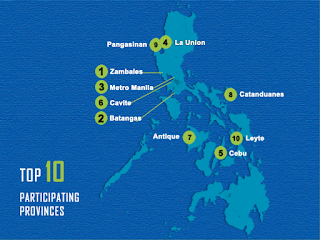 |
| The 32nd ICC on the coast of host town San Narciso, Zambales. |
The Philippines joined the annual global observance of the 32nd
International Coastal Cleanup (ICC) Day on Saturday, 16 September 2017 with the
theme, “Together for our Ocean”.
Zambales was the focal province for the national
observance led by ICC Philippines. San Narciso, our hometown, with an estimated
11,000 volunteers from its seventeen barangays, played host to provincial,
regional and national government officials, CSOs and NGOs.
This year, the aim was to surpass the 2015 number of volunteers but also to promote Zambales as an environment-focused province. Hence, the vision of creating an e-cropolis in the vicinity of Mt. Tapulao in Palauig, a mountain area cooler than Baguio, an ideal site for retirement houses of local and foreign seniors, and for an international convention center.
 |
| Students and teachers walked a kilometer from the town plaza to the cleanup site. |
San Narciso town was conveniently accessible to the volunteers from outside the province being midway between Subic and Iba. It is the surfing capital of the province. It is also implements a marine biodiversity management flagship program-- marine turtle conservation and protection, the only one in Zambales--and this month happens to be the start of the nesting season of the Olive ridley species..
This year’s ICC Day is the fourteenth observance in the
Philippines after its commitment through Presidential Proclamation No. 470
issued on 15 September 2003. There was no nationwide observance last year,
however, because the government declared a state of lawlessness. The Ocean
Observancy accepted the cancellation for the safety of volunteers.
 |
| ICC observance in the Philippines in September 2015. (Source: ICC Philippines 2015 Report) |
In the 30th ICC Day in 2015 though, the
Philippines was the top participating countty with 256,904 volunteers from 47
provinces, who cleaned up 1,162.8 kms of coastline, collecting 301,772 kgs of
trash in the process. Of the total number of volunteers, 308 used watercraft,
and 296 went underwater, to collect debris.
Zambales was number one in the top 10 of volunteers, followed
by Batangas, Metro Manila, La Union, Cebu, Cavite, Antique, Catanduanes,
Pangasinan and Leyte, in that order.
The province had 89,042 volunteers who collected 8,902
bags of trash that weighed approximately 61,407 kg from an estimated 372.1
km-long coastland, the longest in the list. The total of debris items collected
was 5,392,915. Of these, the top ten debris amounted to 3,394,304 items
comprising from the largest to the smallest: food wrappers (1,208,950),
cigarette butts, straws/stirrers, other plastic bags, grocery plastic bags,
plastic bottle caps, plastic take-out/away containers, plastic beverage
bottles, plastic lids, and plastic cups and plates (140,545).
Last year’s 31st ICC Day, with the
non-participation of the Philippines, the top three participating countries
were the United States (183,321 volunteers), Hongkong (76,311), and Canada
(24,475).
 |
| The Top 20 participating countries in ICC Day 2016 and weird items found in the marine debris. (Source: Ocean Observancy's ICC 2017 Report) |
There were 504,583 volunteers from 112 countries and
locations who collected 8,346,055 kgs of marine debris from along 24,136 kms of
beaches, coasts and waterways, comprising 13,840,398 debris items.
 |
| Top 10 items collected in the Philippines on ICC Day 2015. Source: ICC Philippines 2015 Report. |
The ICC was initiated by Ocean Conservancy in 1986 is the
largest volunteer effort held annually every third Saturday of September to deal
with trash, one of the biggest threats to the oceans.
On ICC Day, volunteers around the world remove trash and
debris from beaches, waterways and other water bodies, identify the source of
the debris, and record information on the debris collected. These activities
can ‘change behaviors that cause pollution [and] raise awareness on the extent
of the marine debris problem,’ and data analysis of results can ‘aid in
better-informed policy decisions and improved solid waste management programs.’
Volunteers record the kind and material composition of
objects they collect. The information is ‘instrumental in helping determine the
effects that specific materials are having on ocean habitats. … scientists and
ocean advocates will be able to identify the best remedies and advocate for
solutions that will lead to a healthier ocean.’
 |
| Top 10 items collected worldwide on ICC Day 2016. (Source: Ocean Obsservancy's ICC 2017 Report) |
According to Nicholas Mallos, conservation biologist and
marine debris specialist of Ocean Conservancy: ‘The ability to pinpoint the
types and amounts of material on beaches and in the ocean – not just the kinds
of products – makes the data more informative when supporting marine debris
policy.’
















